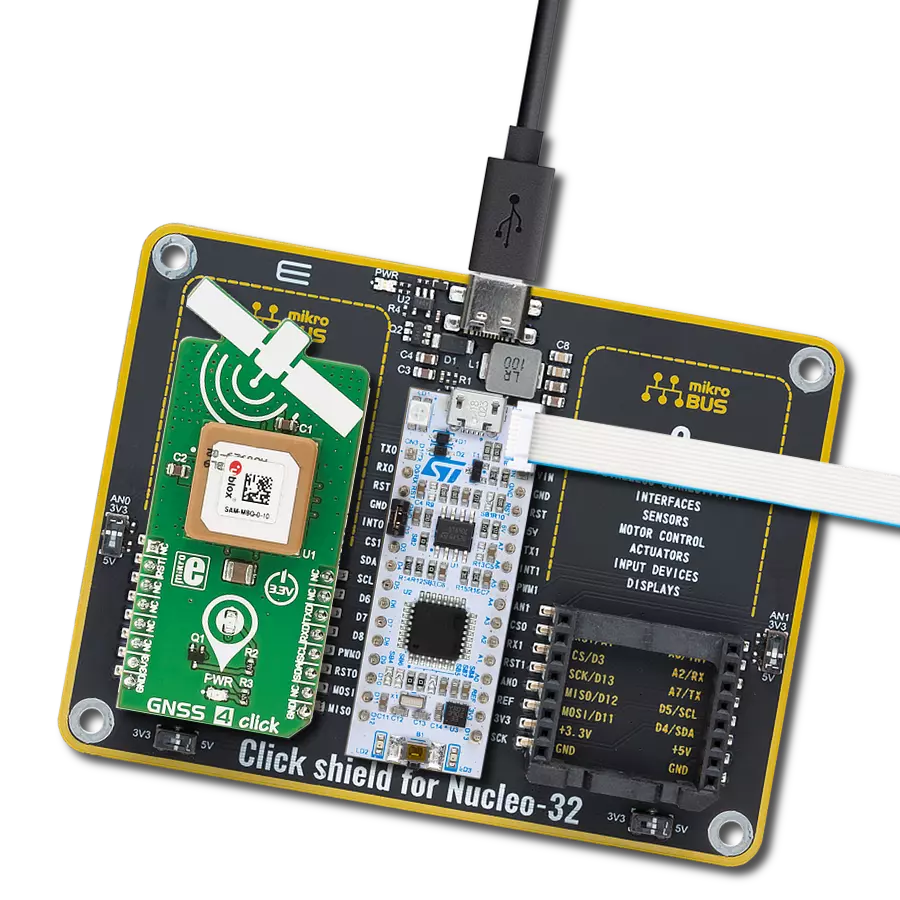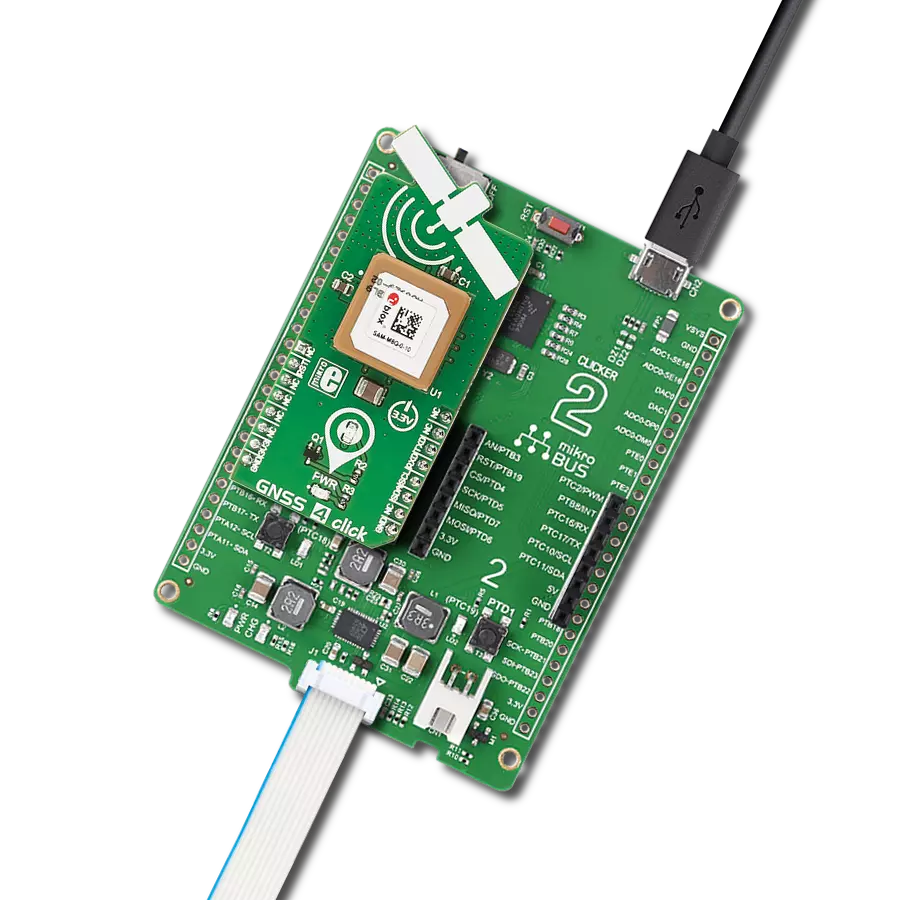Experience the future of navigation with our GPS/GNSS solution, designed to provide seamless, reliable location data for applications that demand precision and efficiency.
A
A
Hardware Overview
How does it work?
Nano GPS 3 Click is based on the ORG1511, a GPS/GNSS module with an integrated antenna from OriginGPS. It is built around MediaTek’s MT3333 SoC, which includes an 8Mb built-in flash, GNSS radio, a DSP core for processing the GNSS signal, a navigation subsystem, a peripheral controller, and a PMU subsystem. The module is 10x10 mm, the industry’s smallest global positioning module, with superior sensitivity and outstanding performance. It can achieve time to first fix (TTFF) in less than one second, location accuracy of approximately two meters, and tracking sensitivity of -165dBm. Its architecture can detect changes in context, temperature, and satellite signals to achieve a state of near-continuous availability by maintaining and updating its internal parameters, such as time, frequency, and satellite ephemeris data. An on-board patch antenna is built from a Hi-K ceramic element and is accompanied by a GNSS SAW Filter and a GNSS dual-stage LNA, which amplifies the GNSS signal to meet the RF down converter
input threshold. The ORG1511 operates in the 1560 up to 1620MHz frequency range and has 99 search channels and 33 simultaneous tracking channels. Additionally, the module features jamming rejection, indoor and outdoor multipath, cross-correlation mitigation, static navigation, assisted navigation, SBAS, DGPS, and more. It can work in full-power continuous, standby, periodic, and AlwaysLocateTM modes. The Nano GPS 3 Click is equipped with a backup battery JST connector as an optional backup power supply. Please note that JST battery connectors are not standardized, so check the polarity before connecting. Another feature of this Click board™ is the Backup Mode that can be entered by the software NMEA command, forcing the module to enter the Idle state. You can also enter the Backup Mode over the BCKM SEL switch, thus disconnecting the VCC power supply. The battery should be connected before switching it to the Backup Mode over the switch. Worth mentioning is a 1PPS LED as a pulse-per-second signal that provides a pulse
signal for timing purposes. Nano GPS 3 Click can use a standard 2-Wire I2C interface to communicate with the host MCU, supporting clock speeds of 400kHz. In addition, over the COMM SEL jumper, you can select a standard UART interface to communicate with the host MCU with commonly used UART RX and TX pins and additional UART RTS and CTS control flow pins. The communication supports a default baud rate of 9600bps. The WUP pin is an output-only for probing to determine if the module is in active mode or Standby/Backup states. With the FON pin (force-on), you can control the power states of the module, say, returning from a backup mode to a full power mode. This Click board™ can be operated only with a 3.3V logic voltage level. The board must perform appropriate logic voltage level conversion before using MCUs with different logic levels. Also, this Click board™ comes equipped with a library containing easy-to-use functions and an example code that can be used as a reference for further development.
Features overview
Development board
EasyPIC v8 is a development board specially designed for the needs of rapid development of embedded applications. It supports many high pin count 8-bit PIC microcontrollers from Microchip, regardless of their number of pins, and a broad set of unique functions, such as the first-ever embedded debugger/programmer. The development board is well organized and designed so that the end-user has all the necessary elements, such as switches, buttons, indicators, connectors, and others, in one place. Thanks to innovative manufacturing technology, EasyPIC v8 provides a fluid and immersive working experience, allowing access anywhere and under any
circumstances at any time. Each part of the EasyPIC v8 development board contains the components necessary for the most efficient operation of the same board. In addition to the advanced integrated CODEGRIP programmer/debugger module, which offers many valuable programming/debugging options and seamless integration with the Mikroe software environment, the board also includes a clean and regulated power supply module for the development board. It can use a wide range of external power sources, including a battery, an external 12V power supply, and a power source via the USB Type-C (USB-C) connector.
Communication options such as USB-UART, USB DEVICE, and CAN are also included, including the well-established mikroBUS™ standard, two display options (graphical and character-based LCD), and several different DIP sockets. These sockets cover a wide range of 8-bit PIC MCUs, from the smallest PIC MCU devices with only eight up to forty pins. EasyPIC v8 is an integral part of the Mikroe ecosystem for rapid development. Natively supported by Mikroe software tools, it covers many aspects of prototyping and development thanks to a considerable number of different Click boards™ (over a thousand boards), the number of which is growing every day.
Microcontroller Overview
MCU Card / MCU

Architecture
PIC
MCU Memory (KB)
32
Silicon Vendor
Microchip
Pin count
28
RAM (Bytes)
3648
Used MCU Pins
mikroBUS™ mapper
Take a closer look
Click board™ Schematic

Step by step
Project assembly
Track your results in real time
Application Output
1. Application Output - In Debug mode, the 'Application Output' window enables real-time data monitoring, offering direct insight into execution results. Ensure proper data display by configuring the environment correctly using the provided tutorial.

2. UART Terminal - Use the UART Terminal to monitor data transmission via a USB to UART converter, allowing direct communication between the Click board™ and your development system. Configure the baud rate and other serial settings according to your project's requirements to ensure proper functionality. For step-by-step setup instructions, refer to the provided tutorial.

3. Plot Output - The Plot feature offers a powerful way to visualize real-time sensor data, enabling trend analysis, debugging, and comparison of multiple data points. To set it up correctly, follow the provided tutorial, which includes a step-by-step example of using the Plot feature to display Click board™ readings. To use the Plot feature in your code, use the function: plot(*insert_graph_name*, variable_name);. This is a general format, and it is up to the user to replace 'insert_graph_name' with the actual graph name and 'variable_name' with the parameter to be displayed.

Software Support
Library Description
This library contains API for Nano GPS 3 Click driver.
Key functions:
nanogps3_parse_gngga- Nano GPS 3 parse GNGGA function.nanogps3_generic_read- Nano GPS 3 data reading function.nanogps3_generic_write- Nano GPS 3 data writing function.
Open Source
Code example
The complete application code and a ready-to-use project are available through the NECTO Studio Package Manager for direct installation in the NECTO Studio. The application code can also be found on the MIKROE GitHub account.
/*!
* @file main.c
* @brief Nano GPS 3 Click example
*
* # Description
* This example demonstrates the use of Nano GPS 3 Click by reading and displaying
* the GPS coordinates.
*
* The demo application is composed of two sections :
*
* ## Application Init
* Initializes the driver and resets the Click board.
*
* ## Application Task
* Reads the received data, parses the GNGGA info from it, and once it receives the position fix
* it will start displaying the coordinates on the USB UART.
*
* ## Additional Function
* - static void nanogps3_clear_app_buf ( void )
* - static err_t nanogps3_process ( nanogps3_t *ctx )
* - static void nanogps3_parser_application ( char *rsp )
*
* @author Nenad Filipovic
*
*/
#include "board.h"
#include "log.h"
#include "nanogps3.h"
static nanogps3_t nanogps3;
static log_t logger;
static char app_buf[ NANOGPS3_RX_DRV_BUFFER_SIZE ];
static int32_t app_buf_len = 0;
/**
* @brief Nano GPS 3 clearing application buffer.
* @details This function clears memory of application buffer and reset its length.
* @return None.
* @note None.
*/
static void nanogps3_clear_app_buf ( void );
/**
* @brief Nano GPS 3 data reading function.
* @details This function reads data from device and concatenates data to application buffer.
* @param[in] ctx : Click context object.
* See #nanogps3_t object definition for detailed explanation.
* @return @li @c 0 - Read some data.
* @li @c -1 - Nothing is read or Application buffer overflow.
* @note None.
*/
static err_t nanogps3_process ( nanogps3_t *ctx );
/**
* @brief Nano GPS 3 parser application.
* @param[in] rsp Response buffer.
* @details This function logs GNSS data on the USB UART.
* @return None.
* @note None.
*/
static void nanogps3_parser_application ( char *rsp );
void application_init ( void )
{
log_cfg_t log_cfg; /**< Logger config object. */
nanogps3_cfg_t nanogps3_cfg; /**< Click config object. */
/**
* Logger initialization.
* Default baud rate: 115200
* Default log level: LOG_LEVEL_DEBUG
* @note If USB_UART_RX and USB_UART_TX
* are defined as HAL_PIN_NC, you will
* need to define them manually for log to work.
* See @b LOG_MAP_USB_UART macro definition for detailed explanation.
*/
LOG_MAP_USB_UART( log_cfg );
log_init( &logger, &log_cfg );
log_info( &logger, " Application Init " );
// Click initialization.
nanogps3_cfg_setup( &nanogps3_cfg );
NANOGPS3_MAP_MIKROBUS( nanogps3_cfg, MIKROBUS_1 );
err_t init_flag = nanogps3_init( &nanogps3, &nanogps3_cfg );
if ( ( UART_ERROR == init_flag ) || ( I2C_MASTER_ERROR == init_flag ) )
{
log_error( &logger, " Communication init." );
for ( ; ; );
}
nanogps3_default_cfg( &nanogps3 );
log_info( &logger, " Application Task " );
}
void application_task ( void )
{
nanogps3_process( &nanogps3 );
if ( app_buf_len > ( sizeof( NANOGPS3_RSP_GNGGA ) + NANOGPS3_NMEA_GNGGA_NUM_ELEMENT ) )
{
nanogps3_parser_application( app_buf );
}
}
int main ( void )
{
/* Do not remove this line or clock might not be set correctly. */
#ifdef PREINIT_SUPPORTED
preinit();
#endif
application_init( );
for ( ; ; )
{
application_task( );
}
return 0;
}
static void nanogps3_clear_app_buf ( void )
{
memset( app_buf, 0, app_buf_len );
app_buf_len = 0;
}
static err_t nanogps3_process ( nanogps3_t *ctx )
{
int32_t rx_size;
char rx_buf[ NANOGPS3_RX_DRV_BUFFER_SIZE ] = { 0 };
if ( NANOGPS3_DRV_SEL_UART == ctx->drv_sel )
{
rx_size = nanogps3_generic_read( &nanogps3, &rx_buf, NANOGPS3_RX_DRV_BUFFER_SIZE );
}
else
{
if ( NANOGPS3_OK == nanogps3_generic_read( ctx, rx_buf, 1 ) )
{
if ( NANOGPS3_DUMMY != rx_buf[ 0 ] )
{
rx_size = 1;
}
}
}
if ( rx_size > 0 )
{
int32_t buf_cnt = 0;
if ( ( app_buf_len + rx_size ) > NANOGPS3_RX_DRV_BUFFER_SIZE )
{
nanogps3_clear_app_buf( );
return NANOGPS3_ERROR;
}
else
{
buf_cnt = app_buf_len;
app_buf_len += rx_size;
}
for ( int32_t rx_cnt = 0; rx_cnt < rx_size; rx_cnt++ )
{
if ( rx_buf[ rx_cnt ] )
{
app_buf[ ( buf_cnt + rx_cnt ) ] = rx_buf[ rx_cnt ];
}
else
{
app_buf_len--;
buf_cnt--;
}
}
return NANOGPS3_OK;
}
return NANOGPS3_ERROR;
}
static void nanogps3_parser_application ( char *rsp )
{
char element_buf[ 100 ] = { 0 };
if ( NANOGPS3_OK == nanogps3_parse_gngga( rsp, NANOGPS3_GNGGA_LATITUDE, element_buf ) )
{
static uint8_t wait_for_fix_cnt = 0;
if ( 0 < strlen( element_buf ) > 0 )
{
log_printf( &logger, "\r\n Latitude: %.2s degrees, %s minutes \r\n",
element_buf, &element_buf[ 2 ] );
nanogps3_parse_gngga( rsp, NANOGPS3_GNGGA_LONGITUDE, element_buf );
log_printf( &logger, " Longitude: %.3s degrees, %s minutes \r\n",
element_buf, &element_buf[ 3 ] );
memset( element_buf, 0, sizeof( element_buf ) );
nanogps3_parse_gngga( rsp, NANOGPS3_GNGGA_ALTITUDE, element_buf );
log_printf( &logger, " Altitude: %s m \r\n", element_buf );
wait_for_fix_cnt = 0;
}
else
{
if ( wait_for_fix_cnt % 5 == 0 )
{
log_printf( &logger, " Waiting for the position fix...\r\n\n" );
wait_for_fix_cnt = 0;
}
wait_for_fix_cnt++;
}
nanogps3_clear_app_buf( );
}
}
// ------------------------------------------------------------------------ END

































